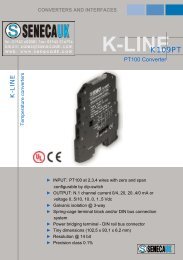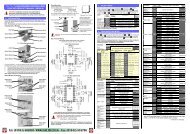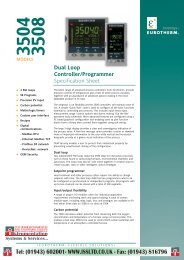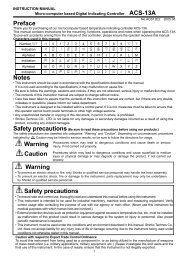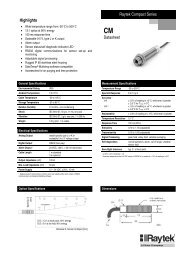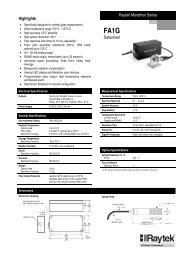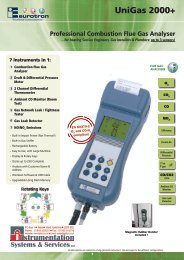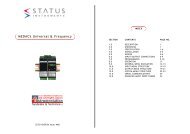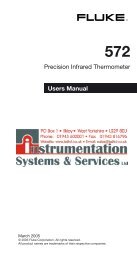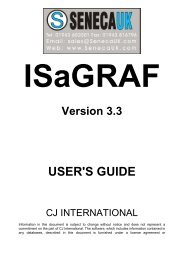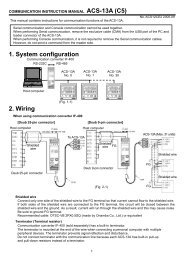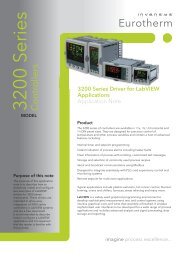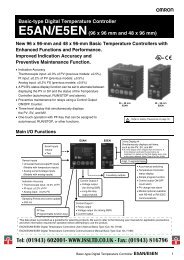to download the Eurotherm piccolo⢠Manual in PDF format
to download the Eurotherm piccolo⢠Manual in PDF format
to download the Eurotherm piccolo⢠Manual in PDF format
Create successful ePaper yourself
Turn your PDF publications into a flip-book with our unique Google optimized e-Paper software.
User <strong>Manual</strong><br />
4.4.7 Sensor Break Alarm, Sbr<br />
A sensor break alarm occurs if <strong>the</strong> sensor or its connections <strong>to</strong> <strong>the</strong> sensor <strong>in</strong>put become<br />
open circuit or greater than a high impedance, see section 5.2.14.1.<br />
It can be configured us<strong>in</strong>g ‘P’ code P35 as follows:-<br />
Piccolo Range<br />
☺<br />
P codes are found<br />
<strong>in</strong> section 5.2.<br />
On This is <strong>the</strong> default state. In opera<strong>to</strong>r levels 1 and 2, Sbr will flash <strong>in</strong> <strong>the</strong> display if <strong>the</strong> sensor is open circuit.<br />
LAt Latch<strong>in</strong>g If an open circuit <strong>in</strong>put occurs <strong>the</strong> alarm will be latched until acknowledged.<br />
The alarm will only reset after it has been repaired. It behaves <strong>the</strong> same as a latched<br />
alarm configured as Nan (<strong>Manual</strong>).<br />
oFF No sensor break alarm An open circuit <strong>in</strong>put will not be detected.<br />
A sensor break alarm can operate <strong>in</strong>dependently of o<strong>the</strong>r alarms.<br />
4.4.8 Sensor Break Safe Output Demand<br />
If a sensor break alarm occurs S.br is displayed and <strong>the</strong> output from <strong>the</strong> controller will adopt a ‘Safe’ level. This is<br />
set us<strong>in</strong>g ‘P’ code P36. The default is 0% which means that all control outputs are off. For a heat/cool controller <strong>the</strong><br />
full range is -100% <strong>to</strong> +100%. It is not limited by <strong>the</strong> Output High and Low limits set <strong>in</strong> Opera<strong>to</strong>r Level 2. The level<br />
set must be chosen with care <strong>to</strong> make sure that <strong>the</strong> process does not over heat or over cool. It may, however, be<br />
useful <strong>to</strong> ma<strong>in</strong>ta<strong>in</strong> a small amount of power <strong>to</strong> keep <strong>the</strong> process at a ‘standby’ temperature if <strong>the</strong> <strong>in</strong>put sensor fails.<br />
If <strong>the</strong> controller is <strong>in</strong> MAN mode (Au<strong>to</strong>/<strong>Manual</strong> = Man) S.br is displayed, but <strong>the</strong> output power does not adopt <strong>the</strong><br />
Safe value but will adopt <strong>the</strong> manually set level.<br />
If <strong>the</strong> controller is <strong>in</strong> standby mode (Au<strong>to</strong>/<strong>Manual</strong> = OFF) S.br will be displayed and <strong>the</strong> outputs will always go <strong>to</strong> off<br />
(0%).<br />
4.4.9 Loop Break Alarm, L.br<br />
The loop break alarm attempts <strong>to</strong> detect loss of res<strong>to</strong>r<strong>in</strong>g action <strong>in</strong> <strong>the</strong> control loop by check<strong>in</strong>g <strong>the</strong> control output,<br />
<strong>the</strong> process value and its rate of change.<br />
The loop is considered <strong>to</strong> be broken if <strong>the</strong> PV does not respond <strong>to</strong> a change <strong>in</strong> <strong>the</strong> output <strong>in</strong> a set amount of time.<br />
S<strong>in</strong>ce <strong>the</strong> time of response will vary from process <strong>to</strong> process <strong>the</strong> Loop Break Alarm Time parameter P34 allows a<br />
time <strong>to</strong> be set before an alarm is <strong>in</strong>itiated. For a PID controller, if <strong>the</strong> PV has not moved by 0.5 x Pb (Proportional<br />
Band) <strong>in</strong> <strong>the</strong> loop break time <strong>the</strong> loop is considered <strong>to</strong> be <strong>in</strong> break. The loop break time is set au<strong>to</strong>matically<br />
follow<strong>in</strong>g an Au<strong>to</strong>-tune, a typical value is 12 x Td (Derivative Time). For an On/Off controller Loop Break Time is not<br />
shown and loop break alarm is <strong>in</strong>hibited. When a loop break is detected <strong>the</strong> output power will drive <strong>to</strong> high or low<br />
limit.<br />
If a loop break alarm occurs <strong>the</strong> ALM beacon flashes <strong>to</strong>ge<strong>the</strong>r with <strong>the</strong> message L.br and OP3 (default) or any o<strong>the</strong>r<br />
output attached <strong>to</strong> <strong>the</strong> Loop Break Alarm operates.<br />
If <strong>the</strong> PV <strong>the</strong>n changes show<strong>in</strong>g that <strong>the</strong> loop is respond<strong>in</strong>g, <strong>the</strong> loop break alarm condition disappears.<br />
Acknowledgement of <strong>the</strong> loop break alarm sets <strong>the</strong> ALM beacon <strong>to</strong> constant if <strong>the</strong> alarm is still present – <strong>the</strong> L.br<br />
message cont<strong>in</strong>ues <strong>to</strong> flash and <strong>the</strong> output rema<strong>in</strong>s active.<br />
Loop break detection works for all control algorithms, PID and ON-OFF.<br />
See also ‘P’ code P34 fur<strong>the</strong>r <strong>in</strong><strong>format</strong>ion.<br />
4.4.10 Current (CT) Alarms<br />
If <strong>the</strong> load current is be<strong>in</strong>g measured us<strong>in</strong>g <strong>the</strong> Current Transformer option, <strong>the</strong>re are three alarm types available:-<br />
Mnemonic Name Alarm Message Displayed<br />
Ld.AL Load Current Alarm Setpo<strong>in</strong>t Ct.Ld<br />
LE.AL Leakage Current Alarm Setpo<strong>in</strong>t Ct.Le<br />
Hc.AL Overcurrent Alarm Setpo<strong>in</strong>t Ct.Hc<br />
The threshold levels for <strong>the</strong>se alarms are set <strong>in</strong> Level 2.<br />
28 Part No HA031260 Issue 1 May -12



